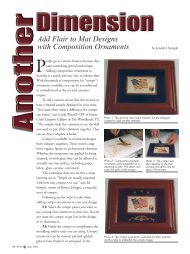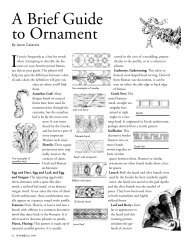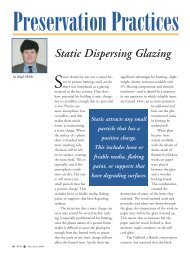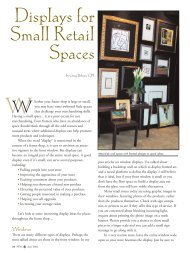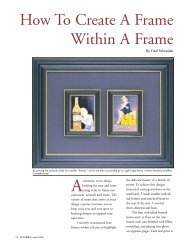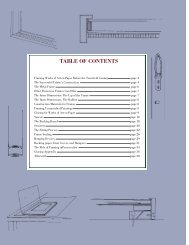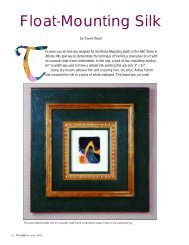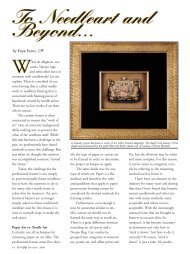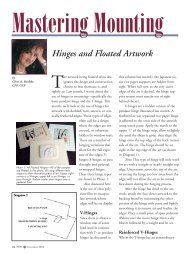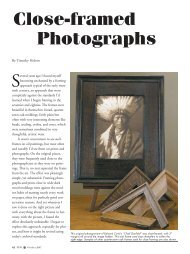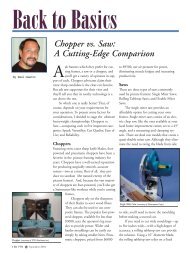Getting the Most from Your Underpinner - Picture Framing Magazine
Getting the Most from Your Underpinner - Picture Framing Magazine
Getting the Most from Your Underpinner - Picture Framing Magazine
You also want an ePaper? Increase the reach of your titles
YUMPU automatically turns print PDFs into web optimized ePapers that Google loves.
<strong>Getting</strong> <strong>the</strong> <strong>Most</strong> <strong>from</strong> <strong>Your</strong> <strong>Underpinner</strong><br />
wedge insertion mechanism are all<br />
factors that determine <strong>the</strong> quality of<br />
<strong>the</strong> joint.<br />
For example, Sarian insists<br />
framers check <strong>the</strong> wedge <strong>the</strong>y are<br />
using for each join. Some framers<br />
use hardwood wedges for all woods,<br />
but Sarian says this may not be in<br />
<strong>the</strong>ir best interest. There are different<br />
wedges for different kinds of<br />
wood. He suggests making a trial<br />
joint with cut-off waste using standard<br />
and hardwood wedges to see<br />
which will give you <strong>the</strong> best end<br />
result for <strong>the</strong> particular wood you<br />
are currently working with.<br />
Hunt offered <strong>the</strong>se directions<br />
<strong>from</strong> Larson-Juhl’s training manual<br />
for joining wood mouldings with<br />
underpinners: (1) Check moulding<br />
rails for correct length and imperfections.<br />
(2) Separate mouldings by<br />
lengths, putting long to your left<br />
and short to your right. (It’s easy to<br />
remember: long and left begin with<br />
“L.”) (3) Using a strong framing<br />
glue, apply to corner of moulding<br />
(after coloring <strong>the</strong> miter). (4) Insert<br />
one short and one long rail into <strong>the</strong><br />
90° angle fence. (5) Adjust sliding<br />
rabbet clamp for moulding width.<br />
(6) Set <strong>the</strong> wedge placement stops.<br />
(7) Set plunger within 2" <strong>from</strong> top<br />
of moulding by using quick release<br />
handle. (8) Depress mechanism for<br />
firing wedges into bottom of moulding.<br />
(9) Repeat for all four corners.<br />
Burke had some additional<br />
points to make about operating an<br />
underpinner. He feels <strong>the</strong> position of<br />
operation, (back vs. front) is one of<br />
personal preference (though some<br />
48 PFM i March 1999<br />
machines might be easier to operate<br />
<strong>from</strong> one direction). Generally a<br />
machine used <strong>from</strong> <strong>the</strong> front will be<br />
mounted higher than one used <strong>from</strong><br />
<strong>the</strong> back.<br />
Burke points out that <strong>the</strong> top<br />
clamp pad is sometimes changeable.<br />
A v-shaped pad will usually work<br />
best for most profiles that have a<br />
shape to <strong>the</strong>m (scoops, reverses, panels,<br />
etc.). For flat mouldings or<br />
round top shapes, a round pad<br />
works well. Some machines have<br />
rubber pads that conform to <strong>the</strong><br />
moulding’s shape as it’s compressed.<br />
A poorly placed pad, can cause a<br />
gapped corner.<br />
Bu rke says a re verse shoe is good<br />
to use for intricate moulding shapes.<br />
A shoe is made <strong>from</strong> <strong>the</strong> cutout of<br />
<strong>the</strong> moulding, when cut in a single or<br />
double miter saw (<strong>the</strong> scrap center<br />
piece). You can also make <strong>the</strong> two<br />
p a rts by turning <strong>the</strong> moulding<br />
a round in <strong>the</strong> cutter and creating two<br />
s h o rt pieces, 2" to 3" long. The triangle<br />
formed by gluing <strong>the</strong>se two pieces<br />
toge<strong>the</strong>r provides a bridge betwe e n<br />
<strong>the</strong> moulding and <strong>the</strong> pad, cre a t i n g<br />
e ven pre s s u re along <strong>the</strong> pro f i l e .<br />
Burke adds that is handy to have<br />
a 4" triangle made form hard material<br />
such as Plexiglas®, masonite or<br />
hardwood. This triangle can be set<br />
on top of a corner before <strong>the</strong> top<br />
pad comes down to displace and<br />
spread out <strong>the</strong> top clamp pressure on<br />
very soft woods. It also helps<br />
machines with round pads conform<br />
to <strong>the</strong> profile shape. If two pieces of<br />
moulding are not exactly <strong>the</strong> same<br />
height, <strong>the</strong> hard triangle allows <strong>the</strong><br />
machine to flush <strong>the</strong> top of <strong>the</strong><br />
moulding while joining, instead of<br />
having <strong>the</strong> bottom of <strong>the</strong> corner<br />
flush (as when you use soft pads).<br />
Ano<strong>the</strong>r triangle, one with vertical<br />
sides applied to one surface, will<br />
help hold some irregular shapes<br />
when joining. The sides should be<br />
made <strong>from</strong> 1 ⁄4" to 3 ⁄8" thick wood and<br />
be 1" to 1 1 ⁄2" high, glued in a v-shape<br />
to <strong>the</strong> corner of <strong>the</strong> triangle on one<br />
surface, allowing it to hold <strong>the</strong> back<br />
side of some reverse mouldings during<br />
joining.<br />
Burke also uses a small 1 ⁄4" dowel<br />
or glue stick that works well when<br />
mouldings have narrow scoops that<br />
don’t allow a top pad to sit in <strong>the</strong><br />
recess. Cut <strong>the</strong> dowel at a 45° angle<br />
on one end and glue two of <strong>the</strong>m<br />
toge<strong>the</strong>r to form a v-shape, 3" to 4"<br />
long on each leg. (If you use a glue<br />
stick, heat <strong>the</strong> ends with a match<br />
shape and press <strong>the</strong>m toge<strong>the</strong>r.)<br />
These dowels are applied to <strong>the</strong><br />
small scoop of <strong>the</strong> corner before <strong>the</strong><br />
top pad comes down and spaces <strong>the</strong><br />
machine pad above <strong>the</strong> moulding so<br />
<strong>the</strong> pressure is applied inside <strong>the</strong><br />
scooped recess. Usually narrow<br />
mouldings only allow <strong>the</strong> pad to sit<br />
on <strong>the</strong> lip, which tends to break<br />
when you try to insert <strong>the</strong> nail.<br />
Materials you use are just as<br />
important as <strong>the</strong> machine itself.<br />
Burke and Butwinski agree that <strong>the</strong><br />
best thing to do is use nails that are<br />
meant for your particular machine<br />
model; incorrect nails create premature<br />
wear on <strong>the</strong> nail driver.<br />
Nails for underpinners come<br />
sharpened in two formats: with a



